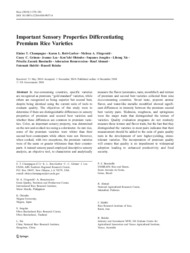Important sensory properties differentiating premium rice varieties.
Important sensory properties differentiating premium rice varieties.
Autoria: CHAMPAGNE, E. T.; BETT-GARBER, K. L.; FITZGERALD, M. A.; GRIMM, C. C.; LEA, J.; OHTSUBO, K.; JONGDEE, S.; XIE, L.; BASSINELLO, P. Z.; RESURRECCION, A.; AHMAD, R.; HABIBI, F.; REINKE, R.
Resumo: In rice-consuming countries, specific varieties are recognized as premium, ?gold standard? varieties, while others are recognized as being superior but second best, despite being identical using the current suite of tools to evaluate quality. The objectives of this study were to determine if there are distinguishable differences in sensory properties of premium and second best varieties and whether these differences are common to premium varieties. Color, an important sensory property, was determined on the raw and cooked rice using a colorimeter. As raw rice, some of the premium varieties were whiter than their second best counterparts while others were not. However, when cooked, with two exceptions, the premium varieties were of the same or greater whiteness than their counterparts. A trained sensory panel employed descriptive sensory analysis, an objective tool, to characterize and analytically measure the flavor (aromatics, taste, mouthfeel) and texture of premium and second best varieties collected from nine rice-consuming countries. Sweet taste, popcorn aroma/flavor, and water-like metallic mouthfeel showed significant differences in intensity between the premium?second best variety pairs. Slickness, roughness, and springiness were the major traits that distinguished the texture of varieties. Quality evaluation programs do not routinely measure these texture and flavor traits, but the fact that they distinguished the varieties in most pairs indicates that their measurement should be added to the suite of grain quality tests in the development of new higher-yielding, stress tolerant varieties. The incorporation of premium quality will ensure that quality is no impediment to widespread adoption leading to enhanced productivity and food security.
Ano de publicação: 2010
Tipo de publicação: Artigo de periódico
Unidade: Embrapa Arroz e Feijão
Palavras-chave: Amilose, Análise sensorial, Arroz, Cor, Oryza sativa, Propriedade organoléptica, Proteína, Qualidade do arroz, Sabor
Observações
1 - Por padrão são exibidas publicações dos últimos 20 anos. Para encontrar publicações mais antigas, configure o filtro ano de publicação, colocando o ano a partir do qual você deseja encontrar publicações. O filtro está na coluna da esquerda na busca acima.
2 - Para ler algumas publicações da Embrapa (apenas as que estão em formato ePub), é necessário ter, no celular ou computador, um desses softwares gratuitos. Sistemas Android: Google Play Livros; IOS: iBooks; Windows e Linux: software Calibre.
Acesse outras publicações
Acesse a Base de Dados da Pesquisa Agropecuária (BDPA) para consultar o acervo completo das bibliotecas da Embrapa.

